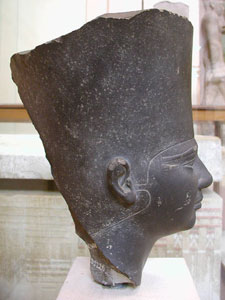
Userkaf (Userkhaf, Weserkaf, “his soul is powerful”) was the founder of the fifth dynasty (Old Kingdom) of Ancient Egypt. His Horus name was Irimaat – “Horus, Who Does What Is Right”. He was probably the grandson of Djedfere. However, the precise identity of his parents is in doubt.
Userkaf was previously considered to be the son of Queen Neferhetepes but excavations of the causeway of his son, Sahure, suggest that he was in fact the husband of Queen Neferhetep and may have been the son of Shepseskhaf and Khentkaus I (who may be the lady known as Reddjedet in the story of Khufu and the Magicians recorded in the Westcar Papyrus).
Alternatively, it has been noted that both Shepseskhaf and Userkaf omitted the name of Ra from their throne name (they are the first pharaohs since Djedfere to have done so). Because of this, and the proximity of their pyramids, Verner has argued that Shepseskaf and Userkaf were the sons of Khentkaus I (who does bear a title which could be translated as “Mother of two kings”).
It is now generally accepted that he was the father of Sahure and he may also have been the father of Neferirkare, although some experts consider he was the grandfather of Neferirkare.

Userkaf and his successors were known as the “Sun Kings”. He was the first pharaoh to build a sun temple at Abu Gurob (near Abusir). His sun temple, named “Nekhen-Re” (“Stronghold of Ra“) included a sun altar and Benben (a truncated obelisk). This temple was a precursor to the sun temples adopted by Akhenaten but was apparently inspired by an earlier sun temple at Iunu (Heliopolis). A bust of Userkaf found here is one of the few examples of an Old Kingdom pharaoh wearing the Deshret (Red Crown) of Lower Egypt.
He built his pyramid across from the pyramid of Shepseskaf near to the enclosure wall of the step pyramid of Djoser at Saqqara. His mortuary temple was at the south, not east of the pyramid. This may have been due to problems with the geography of the area, or may have been because the sun would have shone on the temple all day.
An inscribed stone vessel from his mortuary temple found on Kythera is the earliest indication of a connection between Ancient Egypt and the Agean civilisations. He enlarged the temple of Montu at Djerty (Tod) and may have also undertaken some minor building work in the Delta.
The Turin Kings List states his reign as seven years and this is roughly supported by the Palermo stone which indicates his reign was no more than twelve to fourteen years. Excerpts from Manetho recorded by Africanus give a surprising reign of twenty-eight years, but this is generally considered to be an error.
Pharaoh’s Names
Manetho: Usercheres
Horus Name: Irimaat (above)

Nebty: Irimaat (Who Does What Is Right)

Golden Horus: Nefer bik nebw (The golden falcon is perfect)

Nomen and Prenomen: Userkaf (Abydos Kings List)
Bibliography
- Bard, Kathryn (2008) An introduction to the Archaeology of Ancient Egypt
- Clayton, Peter A (1994) Chronicle of the Pharaohs
- Dodson, A and Hilton, D. (2004) The Complete Royal Families of Ancient Egypt
- Kemp, Barry J (1991) Ancient Egypt: Anatomy of a Civilisation
- Lehner, Mark (1997) The Complete Pyramids
- Malek, J (2000) “The Old Kingdom”, in The Oxford History of Ancient Egypt Ed I. Shaw
- Rice, Michael (1999) Who’s Who in Ancient Egypt
- Verner, Miroslav (1997)The Pyramids
- Wilkinson, Richard H. (2000) The Complete Temples of Ancient Egypt
Copyright J Hill 2010